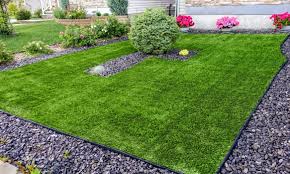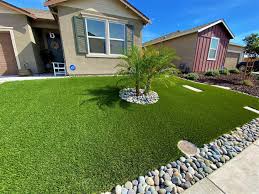Synthetic Grass, which is also called fake grass or artificial turf, is a new and modern way to make your lawn look great. It’s like real grass, but it’s not alive. Many people are using it instead of real grass because it has many good things about it.
One of the best things is that you don’t have to do much to take care of it. Real grass needs a lot of work. You have to cut it with a lawn mower, water it all the time, and put special stuff on it to make it grow well. But with synthetic grass, you don’t need to do those things. It stays green and nice without much help from you.
It’s also really strong. You can walk on it, play on it, and it won’t get hurt. Real grass can sometimes get squished down if you walk or play on it too much, but synthetic grass doesn’t have that problem. It’s like a tough carpet that can handle lots of things.
People like synthetic grass because it lasts a long time. Real grass can sometimes get brown and ugly, especially if the weather is very hot or very cold. But synthetic grass always looks good, no matter the weather. It stays green and pretty all year round.
If you have allergies, synthetic grass might be good for you. Real grass can have things in it that make some people sneeze or feel itchy. But synthetic grass doesn’t have those things, so it’s better for people with allergies.
Another good thing is that it helps save water. Real grass needs a lot of water to stay nice, but synthetic grass doesn’t need much water at all. So, if you live in a place where there isn’t much water, using synthetic grass can help save water.
You can also make your lawn look how you want with synthetic grass. There are different kinds you can choose from. Some have short blades, like a soccer field, and some have longer blades, like the grass in a park. You can pick the one you like the most.
However, synthetic grass is a cool way to make your lawn look good. It’s easy to take care of, strong, lasts a long time, and is good for people with allergies. It’s also good for places where water is scarce. So, if you want a nice lawn without a lot of work, synthetic grass might be the right choice for you.
Read Also: 11 Healing Powers of Siam Weed (Awolowo Leaves) Updated
Benefits of Synthetic Grass

Here are the benefits of synthetic grass explained in more detail:
1. Low Maintenance: Synthetic grass requires very little upkeep compared to natural grass. You won’t need to mow, trim, or fertilize it regularly. This saves you time, energy, and the cost of lawn care equipment.
2. Durability: Artificial turf is designed to withstand heavy foot traffic, making it an excellent choice for areas where people play sports or walk frequently. It doesn’t get worn down or form bald patches like natural grass.
3. Allergy-Friendly: Synthetic grass doesn’t produce pollen, which is a common allergen found in natural grass. This makes it a suitable option for people with allergies, allowing them to enjoy their outdoor space without the discomfort of allergies.
4. Long-Lasting Appearance: Regardless of the weather or the season, synthetic grass maintains its vibrant green appearance. It doesn’t turn brown or dry out during hot summers or cold winters, keeping your outdoor space looking inviting year-round.
5. Environmental Advantages: Synthetic grass conserves water since it doesn’t require regular watering like natural grass does. This is especially beneficial in areas with water scarcity or during droughts. Additionally, its reduced need for pesticides and fertilizers minimizes their negative impact on the environment.
6. Versatile Design Options: You have the freedom to choose the look you want for your outdoor space. With various blade lengths, textures, and shades of green, you can customize your synthetic grass to match your preferred aesthetic.
7. Play and Leisure Areas: Synthetic grass is perfect for recreational spaces, playgrounds, and sports fields. Its durability and soft texture make it safe for children to play on, and it provides a consistent surface for sports activities.
8. Pet-Friendly: Artificial turf is resistant to pet urine and easy to clean. It won’t develop muddy spots, and pet waste can be quickly removed without leaving lingering odors.
9. Reduced Carbon Footprint: Since synthetic grass doesn’t require mowing, it helps reduce the use of gasoline-powered lawn mowers, which contribute to air pollution. Additionally, its longevity minimizes the need for frequent replacements, further reducing environmental impact.
10. Year-Round Enjoyment: With synthetic grass, you can enjoy your outdoor space without worrying about the changing seasons. It remains inviting and functional no matter the weather.
11. Enhances Property Value: A well-maintained lawn adds to the overall appeal of your property. The consistent appearance of synthetic grass can increase your property’s value and curb appeal.
In addition, synthetic grass offers a range of benefits that make it an attractive alternative to natural grass. From low maintenance and durability to its positive impact on the environment, synthetic grass provides a solution that meets both aesthetic and practical needs for a variety of outdoor spaces.
Caring for Synthetic Grass

Caring for synthetic grass is simple and requires minimal effort. Here’s a guide to help you maintain your artificial turf and keep it looking its best:
1. Regular Brushing: Gently brush the synthetic grass using a soft-bristle broom or a specialized turf brush. This helps keep the blades upright and prevents them from matting down, ensuring a natural appearance.
2. Clear Debris: Remove leaves, sticks, and other debris from the surface regularly. This prevents organic matter from accumulating and potentially causing mold or mildew growth.
3. Rinse Occasionally: To remove dust and dirt, give your synthetic grass a light rinse with water. You can use a hose or a gentle spray attachment to wash away surface particles. This also helps keep the grass looking fresh.
4. Pet Waste Cleanup: Scoop and remove solid pet waste promptly. Rinse the affected area with water to ensure cleanliness. Synthetic grass is resistant to pet urine, but occasional rinsing can help prevent odors.
5. Address Stains Promptly: If you notice any stains on the synthetic grass, treat them promptly. Use a mild detergent diluted in water and gently scrub the stained area. Rinse thoroughly to remove any residue.
6. Prevent Weeds: While synthetic grass is less prone to weeds, occasionally inspect the edges and seams for any unwanted growth. Use a weed barrier fabric beneath the turf during installation to help prevent weeds from taking root.
7. Avoid Heavy Objects: Prevent placing heavy furniture or objects on the synthetic grass for extended periods. This can flatten the blades and affect the appearance of the turf.
8. Use Caution with Heat: Synthetic grass can become hot in direct sunlight. If you live in a hot climate, avoid walking on the grass during the hottest part of the day or use a hose to cool it down before use.
9. Professional Maintenance: Consider scheduling professional maintenance once or twice a year. Professionals can perform tasks like deep cleaning, removing debris from the infill, and checking for any necessary repairs.
10. Repair as Needed: If you notice any tears, fraying, or damage to the synthetic grass, address it promptly. Small repairs can prevent more significant issues from developing.
By following these simple care tips, you can ensure that your synthetic grass retains its lush appearance and remains a beautiful addition to your outdoor space for years to come.
Read Also: All You Need To Know About Grass Hoppers
Synthetic Grass Cost
Synthetic grass cost is a significant consideration when opting for this modern landscaping solution. While the initial investment may vary based on factors such as quality, area size, and installation complexity, it’s essential to view the cost of synthetic grass as an investment that delivers long-term benefits and value.
Initial Installation Investment: The cost of synthetic grass installation encompasses various components, including the synthetic grass material itself, labor, infill, and additional materials required for a successful installation. The quality and type of synthetic grass you choose will influence the initial price. Higher-quality options with advanced technology and a more realistic appearance often come at a slightly higher cost.
Area Size and Complexity: The size of the area you intend to cover with synthetic grass directly impacts the overall cost. Larger spaces require more materials and labor, contributing to higher expenses. Additionally, if your installation involves intricate features, slopes, or unique design elements, the complexity of the project can influence the cost.
Site Preparation: Proper site preparation is crucial for a successful synthetic grass installation. Depending on the condition of your existing lawn, site preparation can involve tasks such as removing old grass, leveling the ground, and creating a suitable base. The extent of site preparation required can affect the overall cost.
Additional Materials: Infill material, which is used to add stability and cushioning to the synthetic grass, is an essential component of the installation process. The type and amount of infill needed can impact the overall cost. Some installations may also require specialized adhesives, edging materials, or other accessories.
Professional Installation: While it’s possible to install synthetic grass yourself, hiring professional installers ensures a proper and lasting installation. While this adds to the upfront cost, it guarantees a high-quality result and minimizes the risk of future issues. Professional installation also saves you time and effort.
Long-Term Savings: While the initial investment in synthetic grass may be higher than natural grass, it’s essential to consider the long-term savings. Synthetic grass requires minimal maintenance, saving you money on lawn care equipment, water bills, and ongoing maintenance tasks. Over the years, these savings can add up significantly.
Warranty and Lifespan: Many synthetic grass options come with warranties that cover certain aspects of performance, such as fading and durability. A longer warranty period may contribute to a slightly higher upfront cost but can provide you with peace of mind regarding the quality and longevity of your investment.
In conclusion, while the initial cost of synthetic grass may require an investment, it is very important to consider the long-term benefits, savings, and value it provides. With its low maintenance, durability, and aesthetic appeal, synthetic grass offers a modern and sustainable landscaping solution that enhances your outdoor space for years to come.
When evaluating synthetic grass cost, remember to factor in the convenience, durability, and long-term savings that make it a worthwhile choice for homeowners and property owners seeking a vibrant and low-maintenance lawn.
Read Also: Composting Equipment: What You Need to Know
